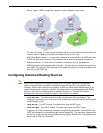
Network > Routing
239
SonicOS Enhanced 4.0 Administrator Guide
RIP Modes
• Disabled – RIP is disabled on this interface
• Send and Receive – The RIP router on this interface will send updates and process
received updates.
• Send Only – The RIP router on this interface will only send updates, and will not process
received updates. This is similar to the basic routing implementation.
• Receive Only – The RIP router on this interface will only process received updates.
• Passive – The RIP router on this interface will not process received updates, and will only
send updates to neighboring RIP routers specified with the CLI ‘neighbor’ command. This
mode should only be used when configuring advanced RIP options from the ars-rip CLI.
Receive (Available in ‘Send and Receive’ and ‘Receive Only’ modes)
• RIPv1 – Receive only broadcast RIPv1 packets.
• RIPv2 – Receive only multicast RIPv2 packets. RIPv2 packets are sent by multicast,
although some implementations of RIP routers (including basic routing on SonicWALL
devices) have the ability to send RIPv2 in either broadcast or multicast formats.
Note Be sure the device sending RIPv2 updates uses multicast mode, or the updates will not be
processed by the ars-rip router.
Send (Available in ‘Send and Receive’ and ‘Send Only’ modes)
• RIPv1 – Send broadcast RIPv1 packets.
• RIPv2 - v1 compatible – Send multicast RIPv2 packets that are compatible with RIPv1.
• RIPv2 – Send multicast RIPv2 packets.
Split Horizon – Enabling Split Horizon will suppress the inclusion of routes sent in updates to
routers from which they were learned. This is a common RIP mechanism for preventing routing
loops. See the ‘maximum hops’ entry at the start of Advanced Routing Services section.
Poisoned Reverse – Poison reverse is an optional mode of Split Horizon operation. Rather than
suppressing the inclusion of learned routes, the routes are sent with a metric of infinity (16) thus
indicating that they are unreachable. See the ‘maximum hops’ entry at the start of Advanced
Routing Services section.
Use Password – Enables the use of a plain-text password on this interface, up to 16 alpha-
numeric characters long, for identification.
Default Metric – Used to specify the metric that will be used when redistributing routes from
other (Default, Static, Connected, OSPF, or VPN) routing information sources. The default
value (undefined) is 1 and the maximum is 15.
Administrative Distance – The administrative distance value is used by routers in selecting a
path when there is more than one route to a destination, with the smaller distance being
preferred. The default value is 120, minimum is 1, and maximum is 255.
Originate Default Route – This checkbox enables or disables the advertising of the
SonicWALL’s default route into the RIP system.
Redistribute Static Routes – Enables or disables the advertising of static (Policy Based
Routing) routes into the RIP system. The metric can be explicitly set for this redistribution, or it
can use the value (default) specified in the ‘Default Metric’ setting.


















